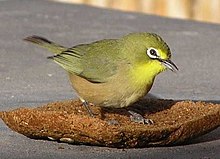Orange River white-eye
| Orange River white-eye | |
|---|---|

| |
| Adult bird, lower Orange River, showing the sulphur-coloured face markings and tawny buff flanks and sides of breast | |
| Scientific classification | |
| Domain: | Eukaryota |
| Kingdom: | Animalia |
| Phylum: | Chordata |
| Class: | Aves |
| Order: | Passeriformes |
| Family: | Zosteropidae |
| Genus: | Zosterops |
| Species: | Z. pallidus
|
| Binomial name | |
| Zosterops pallidus Swainson, 1838
| |

| |
| range[1][2]
Z. pallidus only
Z. pallidus in sympatry with Z. virens
Cape white-eye (Z. virens) only
| |
The Orange River white-eye (Zosterops pallidus) is a species of bird in the family
Subspecies
Four subspecies have been proposed based on plumage colour and size differences:[2]
- Zosterops pallidus pallidus — Northern Cape, North West, Gauteng, Free State
- Zosterops pallidus sundevalli Hartlaub — tributaries of upper Orange and lower to mid Vaal River
- Zosterops pallidus deserticola Reichenow — lower Orange River and its tributaries
- Zosterops pallidus haigamchabensis — northern Namibia to Northern Cape, South Africa
Range
It occurs at highest densities in the catchment areas of the
Habitat
Forages in native and introduced willows (
Description
The sexes are alike and
Habits
They glean insects from foliage and tree bark, but also take small fruit, including dry Searsia berries.[2] Outside the breeding season they move about in small foraging parties. Individuals loosely follow the trail of a leading bird, and they have been noticed to mix with non-breeding Cape white-eyes. The usual song is subdued and muted except when excited,[2] but a sustained warbling song is heard in the breeding season.
Nesting
They breed during the summer months. Breeding information is very incomplete,[2] but a clutch of three pale blue eggs has been recorded.[2] Dry pliable plant material is used in building the deep cup nest, which is slung between horizontal twigs and strengthened with cobweb.[3]
Gallery
-
Perched on a Phragmitis reed near Aussenkehr, lower Orange River
-
Near Aussenkehr on the lower Orange River
References
- ^ ISBN 0-620-20730-2. Retrieved 11 July 2016.
- ^ ISBN 0-620-34053-3.
- ISBN 1-86872-616-9.



